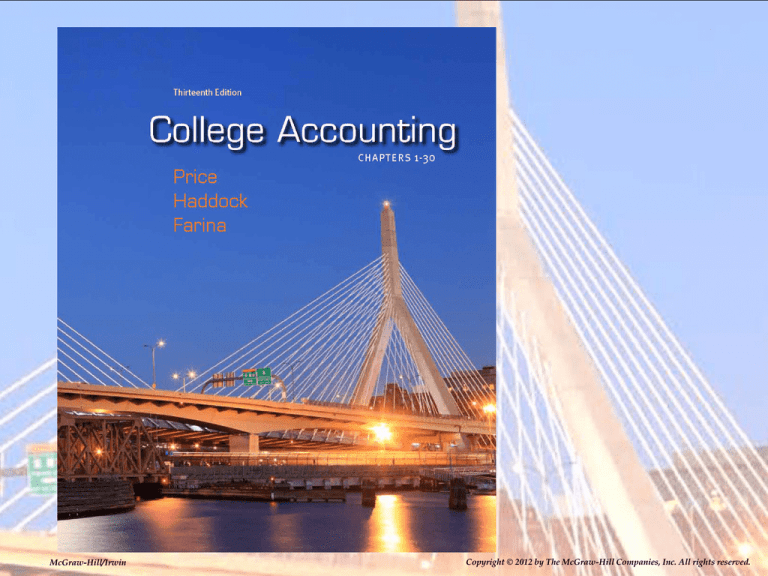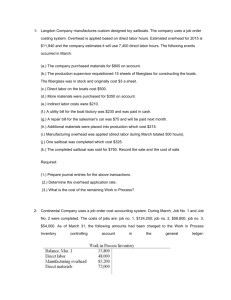
McGraw-Hill/Irwin
1-1
Copyright © 2012 by The McGraw-Hill Companies, Inc. All rights reserved.
27-1
Chapter
27
Job Order
Cost Accounting
Section 1: Cost Accounting
Section Objectives
1.
Explain how a job order cost accounting system
operates.
27-2
Types of Cost Accounting
Systems
A job order cost accounting system is used
by businesses that produce special orders or
produce more than one product in batches.
A process cost accounting system is used when
standard products are manufactured using a
continuous process.
A standard cost accounting system, in which
standard costs of production are measured, can be
used with a job order or a process cost system.
27-3
Flow of Costs through a Job Order Cost
Accounting System
Procurement
Production
Warehousing
Raw Materials
Inventory
Work in Process
Inventory
Finished Goods
Inventory
Purchases
Issued
Materials
Labor
Transferred
out
Transferred
in
Transferred
out
Selling
Cost of Goods Sold
Transferred
in
Overhead
Wages
Payable
Charged to
Work in
Process
Manufacturing
Overhead
Indirect
Materials
Indirect
Labor
Applied
to Work in
Process
Other
27-4
Perpetual Inventory System
The perpetual inventory system tracks
inventories on hand at all times.
The following accounts are involved in a
perpetual inventory system:
Raw Materials Inventory
Wages Payable
Manufacturing Overhead
Work in Process Inventory
Finished Goods Inventory
Cost of Goods Sold
27-5
Computing the Balance of the
Work in Process Inventory
Beginning inventory of work in process
Add direct materials, direct labor, and manufacturing
overhead charged to production
Deduct cost of goods completed
Ending inventory of work in process
xx
xx
xx
xx
xx
Reflects the cost of partially completed units
27-6
Computing the Balance of
Finished Goods Inventory
Beginning inventory of finished goods
Add cost of goods manufactured
Deduct cost of goods sold
Ending inventory of finished goods
xx
xx
xx
xx
xx
Represents the cost of finished goods on hand
27-7
Just-in-Time Inventory Systems
Used by companies who wish to eliminate raw
materials inventory.
Raw materials ordered to arrive just in time to be
placed into production.
Costs of arriving materials placed immediately
into Work in Process Inventory.
Reduces amount of capital tied up in inventory.
Reduces inventory storage space.
Reduces costs for storeroom personnel,
insurance, and recordkeeping.
27-8
Chapter
27
Job Order
Cost Accounting
Section 2: Job Order Cost
Accounting System
Section Objectives
2.
3.
4.
5.
6.
Journalize the purchase and issuance of direct and indirect
materials.
Maintain perpetual inventory records.
Record labor costs incurred and charge labor into production.
Compute overhead rates and apply overhead to jobs.
Compute overapplied or underapplied overhead and report it in
the financial statements.
27-9
Cost Basis
When pricing the raw materials inventory, three
common methods are used:
FIFO
LIFO
Average Cost
Each method reflects a different valuation of
raw materials inventory.
Each company determines its own pricing
policy.
27-10
Labor Costs
Workers complete a
separate time ticket
for each job.
All labor time tickets
are sorted by job,
summarized at end of
the payroll period, and
entered on job order
cost sheets.
The total charged to
all cost sheets must
agree with direct labor
debited to Work in
Process Inventory.
27-11
Recording Labor Costs
27-12
Objective 5
Compute overhead rates and apply
overhead to jobs
Manufacturing Overhead
Includes all manufacturing costs except
direct materials and direct labor.
Examples:
Indirect materials
Indirect labor
Depreciation
Insurance
Utilities
Rent
27-13
Applying Overhead to Jobs
Overhead costs are applied to specific jobs
based on an overhead application rate.
Several different bases can be used to develop
the overhead application rate. Some of more
common bases for allocating overhead are:
Based on direct labor costs.
Based on direct labor hours
Based on machine hours.
27-14
Compute overapplied or underapplied overhead
Objective 6 and report it in the financial statements
Determining Overapplied
or Underapplied Overhead
At month-end, compare the total credits in Manufacturing
Overhead Applied to the total debits in Manufacturing
Overhead.
If credits in Manufacturing Overhead Applied are less than
debits in Manufacturing Overhead, overhead has been
underapplied.
If debits in Manufacturing Overhead are less than credits in
Manufacturing Overhead Applied, overhead has been
overapplied.
27-15
Chapter
27
Job Order
Cost Accounting
Section 3: Accounting for
Job Orders
Section Objectives
7.
Maintain job order cost sheets.
8.
Record the cost of jobs completed and the cost of
goods sold under a perpetual inventory system.
27-16
Objective 7
Maintain job order cost sheets
Job Order Cost Sheet
Each job started in production has its own job order cost
sheet.
The cost sheets constitute the subsidiary ledger for the Work
in Process account. The job cost sheet totals should equal the
general ledger account balance.
The cost sheet shows:
Direct materials
Direct labor
Overhead
27-17
Job Order Cost Sheet
Enter materials used
Enter labor costs
Apply overhead
using predetermined
rate
Total the costs when
the job is completed
27-18
Cost of Goods Sold
(Perpetual Inventory)
Instead of showing overapplied or underapplied overhead on
the income statement, the accountant might prefer to show
actual manufacturing costs on the statement of cost of goods
manufactured.
27-19






